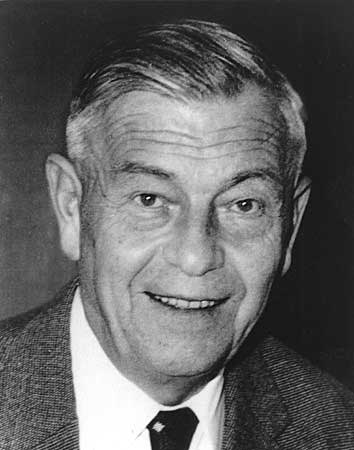Eduard Küsters was born in Germany in 1905. Between the years 1911 and 1919, he attended Volksschule Crefeld-Fischeln, followed by two years at Gewerbliche Tagesschule Crefeld. In 1920, he graduated from Handwerker und Kunstgewerbeschule Crefeld as a journeyman.
Mr. Küsters received his practical training with Gebr. Schroers Werkzeugmaschinenfabrik, Crefeld, between 1920 and 1923, after which he became a fitter and design engineer. Between the years 1926 and 1943, he worked for Deutsche Edelstahlwerke, Krefeld (by this time, the city had changed the spelling of its name) as a master craftsman and chief instructor, followed by six years as technical director at Dornbusch and Company, Krefeld. In 1949, he opened a development center for textile machinery in Krefeld, and in 1953, when he was 48 years old, he founded Eduard Kusters Maschinenfabrik.
Mr. Küsters’ fields of professional specialization include finishing of textile fabric, finishing of paper (calendering), and continuous production of wood fiber board (cardboard).
He holds 450 German patents and about 3000 patents worldwide, including the United States Patent for pressure treatment of material and for continuous press. Most notable is his patent for the development of the self-aligning Swimming Roll Kusters to control press nips in press sections and the nips in machine calenders, soft calenders and super calenders. The first application of the Swimming Roll Küsters was for padders used to dye textile fabrics, the two swimming rolls controlling the nip.
In 1960, the first Swimming Roll Küsters was installed in the press section of a paper machine. Starting in 1961, the paper industry worldwide acknowledged this invention. Today, there is no paper or board machine that does not feature in each press nip and in each calender self-aligning rolls that make the control of the nip possible and, hence, the control of the paper and board profile. Regardless of who the suppliers may be today, the technology is based on the unique idea and invention of Mr. Küsters, and Eduard Küsters Maschinenfabrik is still the leading manufacturer in the field. The technological advances of this invention were the key to the increase of paper and board width from 200 inches up to 400 inches and increased profile correctness, providing manufacturers with considerable economic advantages.
Under his leadership, Eduard Küsters Maschinenfabrik also has additional improved designs on the market today, such as the Hydro Vario Roll and the Multi Hydro Vario Roll, where the nip can be controlled zonewise enabling control to decrease breakage and increase sheet consistency.
Mr. Küsters held professional memberships in Verein Deutscher lngenieure; Gesellschaft der Freunde und Forderer der Staatlichen lngenieurschule fur Maschinenwesn, Krefeld; VTCC Verein der Textilchemiker und Coloristen, Heidelberg; SVFSchweiz. Vereinigung von Farbereifachleuten, Basel; and he was a member of the board of examiners for lndustrie unt Handelskammer, Krefeld.
In 1978, Mr. Küsters received the Max-Krehren-Medaillie through “Der Verein Deutscher Farber e.V.”
Mr. Küsters died in 1987, and condolences were sent from papermakers all over the world. All of those letters emphasized Eduard Küsters’ contribution to the paper industry, since his invention made possible the breakthrough in the concept of paper machines as they are known today. He is survived by his widow, who lives in Krefeld.
